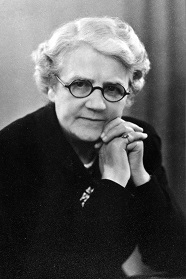The role of SOAS in 178 Years of Chinese Studies in the UK
Exactly 178 years ago, in 1837, the University of London established the UK’s first-ever professorship for Chinese, heralding the founding of Chinese Studies in this country. The Chair of Chinese is linked to a collection of Chinese books donated to the University in 1834 by the missionary Robert Morrison. The “Morrison collection” lay at the basis of what is now one of Europe’s largest collections of Chinese books, held at the SOAS Library. Since SOAS was established in 1916 it has been home to the London Chair of Chinese.
Among early holders of the London Chair, the most famous was Professor Reginald Johnston, a career diplomat who at one time served as English tutor to China’s last emperor. After his retirement, the Chair passed to Prof Evangeline Edwards, who at the time of her appointment in 1939 must have been one of the first female professors in the country.

Evangeline Edwards, Professor of Chinese, was one of the first female Professors at SOAS (SOAS Archive: SOAS/SPA/4/51)
SOAS enjoys a global reputation for its scholarship in classical Chinese philosophy. This reputation was built from the 1950s onwards and culminated in the appointment of Prof D. C. Lau, who translated the Confucian and Daoist classics for the Penguin Classics series, to the Chair of Chinese in 1970, and the promotion of Prof Angus Graham, famous for his studies of Daoist texts and his pedagogical writings on classical Chinese grammar, to a personal professorship in 1971. (Incidentally, his appointment to the London Chair made D. C. Lau the first-ever Chinese person to hold a professorship in Chinese Studies in the UK.) Nowadays at SOAS, Prof Bernhard Fuehrer continues this tradition with his research into the exegetical traditions of the Confucian classics. Some of today’s leading authorities in the study of Chinese philosophy (such as Prof Roger Ames of the University of Hawai’i) were trained at SOAS.
While SOAS’s reputation in the field of classical studies was at its zenith in the 1970s and Chinese Studies in Europe in general were largely focused on China’s past rather than its present, SOAS scholars made a breakthrough with the founding of the Contemporary China Institute (CCI) and its flagship publication The China Quarterly. Outstanding SOAS scholars who were trained at the CCI include Prof Robert Ash (Economics) and the late Prof Elisabeth Croll (Anthropology, Development Studies, Women’s Studies). Many scholars who went on to establish contemporary China studies as an international academic field, including Prof Peter Nolan (Cambridge) and Prof David Goodman (Sydney), were postdoctoral fellows of the CCI. A series of widely consulted monographs on contemporary China was published under the CCI name by Cambridge University Press and later Oxford University Press and continues to be held in high esteem. The China Quarterly is the world’s most-cited area studies journal and also enjoys a wide readership among political, diplomatic, and business communities.

Peony and Emperor Puyi’s inscription to Johnston. Chen Shu huahui (Album of flower paintings), China, 17th century. H25.5 x W36.0cm. MS 62612, leaf 1 and verso of front cover. R.F. Johnston Bequest. An album of 10 paintings presented by Puyi, the last emperor of China, to his tutor Sir Reginald Johnston, the first Professor of Chinese at SOAS. Contadini, Anna (ed.), Objects of Instruction: Treasures of the School of Oriental and African Studies (London, 2007), p. 11, cat. 4.
Adding to its significance, SOAS has had among its staff some famous Chinese literary figures, including the novelist Lao She, who taught at the School in the 1920s, the translator Xiao Qian, who taught at SOAS in the 1940s and went on to translate Ulysses into Chinese, and the writer Jung Chang, whose autobiography Wild Swans has done more to shape public perception of China than any other book ever published.
Today, SOAS houses what we believe to be the largest community of China scholars under one roof in Europe, possibly in the entire Western world. It also houses by far the largest Chinese language programme in our country. What characterizes the unique nature of Chinese Studies at the University of London is a consistent emphasis on combining academic excellence with practical pedagogy and outreach to the community.
